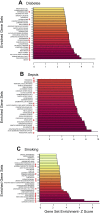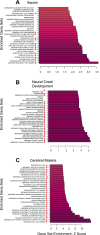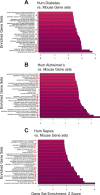Disease and phenotype gene set analysis of disease-based gene expression in mouse and human
- PMID: 20682848
- PMCID: PMC2957794
- DOI: 10.1152/physiolgenomics.00008.2010
Disease and phenotype gene set analysis of disease-based gene expression in mouse and human
Abstract
The genetic contributions to common disease and complex disease phenotypes are pleiotropic, multifactorial, and combinatorial. Gene set analysis is a computational approach used in the analysis of microarray data to rapidly query gene combinations and multifactorial processes. Here we use novel gene sets based on population-based human genetic associations in common human disease or experimental genetic mouse models to analyze disease-related microarray studies. We developed a web-based analysis tool that uses these novel disease- and phenotype-related gene sets to analyze microarray-based gene expression data. These gene sets show disease and phenotype specificity in a species-specific and cross-species fashion. In this way, we integrate population-based common human disease genetics, mouse genetically determined phenotypes, and disease or phenotype structured ontologies, with gene expression studies relevant to human disease. This may aid in the translation of large-scale high-throughput datasets into the context of clinically relevant disease phenotypes.
Figures




Similar articles
-
Systematic analysis, comparison, and integration of disease based human genetic association data and mouse genetic phenotypic information.BMC Med Genomics. 2010 Jan 21;3:1. doi: 10.1186/1755-8794-3-1. BMC Med Genomics. 2010. PMID: 20092628 Free PMC article.
-
BubbleGUM: automatic extraction of phenotype molecular signatures and comprehensive visualization of multiple Gene Set Enrichment Analyses.BMC Genomics. 2015 Oct 19;16:814. doi: 10.1186/s12864-015-2012-4. BMC Genomics. 2015. PMID: 26481321 Free PMC article.
-
MORPHIN: a web tool for human disease research by projecting model organism biology onto a human integrated gene network.Nucleic Acids Res. 2014 Jul;42(Web Server issue):W147-53. doi: 10.1093/nar/gku434. Epub 2014 May 26. Nucleic Acids Res. 2014. PMID: 24861622 Free PMC article.
-
Associating phenotypes with molecular events: recent statistical advances and challenges underpinning microarray experiments.Funct Integr Genomics. 2006 Jan;6(1):1-13. doi: 10.1007/s10142-005-0006-z. Epub 2005 Nov 15. Funct Integr Genomics. 2006. PMID: 16292543 Review.
-
Role of skeletal muscle in mandible development.Histol Histopathol. 2014 Nov;29(11):1377-94. doi: 10.14670/HH-29.1377. Epub 2014 May 27. Histol Histopathol. 2014. PMID: 24867377 Review.
Cited by
-
Temporal dynamics and genetic control of transcription in the human prefrontal cortex.Nature. 2011 Oct 26;478(7370):519-23. doi: 10.1038/nature10524. Nature. 2011. PMID: 22031444 Free PMC article.
-
Microarray analysis of aging-associated immune system alterations in the rostral ventrolateral medulla of F344 rats.Physiol Genomics. 2017 Aug 1;49(8):400-415. doi: 10.1152/physiolgenomics.00131.2016. Epub 2017 Jun 16. Physiol Genomics. 2017. PMID: 28626023 Free PMC article.
-
IL-10 transcription is negatively regulated by BAF180, a component of the SWI/SNF chromatin remodeling enzyme.BMC Immunol. 2012 Feb 15;13:9. doi: 10.1186/1471-2172-13-9. BMC Immunol. 2012. PMID: 22336179 Free PMC article.
-
AMPK agonist AICAR improves cognition and motor coordination in young and aged mice.Learn Mem. 2014 Jan 17;21(2):119-26. doi: 10.1101/lm.033332.113. Learn Mem. 2014. PMID: 24443745 Free PMC article.
-
Exercise is associated with younger methylome and transcriptome profiles in human skeletal muscle.Aging Cell. 2024 Jan;23(1):e13859. doi: 10.1111/acel.13859. Epub 2023 May 2. Aging Cell. 2024. PMID: 37128843 Free PMC article.
References
-
- Ashburner M, Ball CA, Blake JA, Botstein D, Butler H, Cherry JM, Davis AP, Dolinski K, Dwight SS, Eppig JT, Harris MA, Hill DP, Issel-Tarver L, Kasarskis A, Lewis S, Matese JC, Richardson JE, Ringwald M, Rubin GM, Sherlock G; The Gene Ontology Consortium. Gene ontology: tool for the unification of biology. Nat Genet 25: 25–29, 2000. - PMC - PubMed
-
- Attia J, Ioannidis JP, Thakkinstian A, McEvoy M, Scott RJ, Minelli C, Thompson J, Infante-Rivard C, Guyatt G. How to use an article about genetic association. A: Background concepts. JAMA 301: 74–81, 2009. - PubMed
-
- Barnes KC. Gene-environment and gene-gene interaction studies in the molecular genetic analysis of asthma and atopy. Clin Exp Allergy 29, Suppl 4: 47–51, 1999. - PubMed
-
- Becker KG, Barnes KC, Bright TJ, Wang SA. The genetic association database. Nat Genet 36: 431–432, 2004. - PubMed
Publication types
MeSH terms
Grants and funding
LinkOut - more resources
Full Text Sources
Molecular Biology Databases

